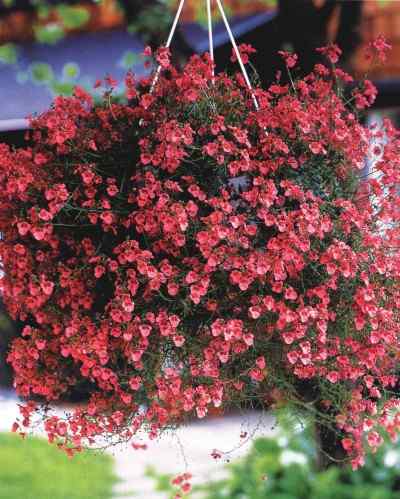
by Sheila Dunning | Nov 4, 2014
 Since 2005, multiple varieties of Diascia have added to the U.S. fall market of winter flowering plants. Its delicate flowers are far from ordinary though. In the early part of the last century most British gardening encyclopedias listed just one diascia – Diascia barberae – derived from seed collected by Col. J. H. Bowker and sent by Mrs. Barber to Kew Gardens, England, in 1870. Annual and perennial diascias had, of course, already been discovered and classified by several botanists visiting South Africa much earlier. The dainty, little annual, Diascia barberae, is not a very showy flower, but one which will appeal to the true flower lover. The flowers are rosy pink with yellow-green spots in the throat. The flowers are lipped, being related to the Snapdragons, but have two spurs on the lower lips, and are sometimes called twinspur. It was not until John Kelly was given a plant called Diascia cordata by Edrom Nurseries in 1971 that anything notable happened to diascias again. He took pollen from his Diascia cordata and applied it to one flower of Diascia barberae. Of the nine seeds he obtained, just one was worthy of attention. He named it Diascia ‘Ruby Field’ (not for the color of the flowers, but for a lady who devoted her live to the long-term care of deprived children). Despite the popularity of this new, hardy hybrid, little more happened with diascias for yet another decade. The boom in the diascia trade began only recently. Today’s diascia offers larger flowers, larger plants with a more open growth habit and colors ranging from scarlet through salmon and coral into pink. They bloom throughout the cooler weather and may behave as a perennial in warmer sites. But, the uniqueness of their flower structure and ecological role are as fascinating as the flower is beautiful.
Since 2005, multiple varieties of Diascia have added to the U.S. fall market of winter flowering plants. Its delicate flowers are far from ordinary though. In the early part of the last century most British gardening encyclopedias listed just one diascia – Diascia barberae – derived from seed collected by Col. J. H. Bowker and sent by Mrs. Barber to Kew Gardens, England, in 1870. Annual and perennial diascias had, of course, already been discovered and classified by several botanists visiting South Africa much earlier. The dainty, little annual, Diascia barberae, is not a very showy flower, but one which will appeal to the true flower lover. The flowers are rosy pink with yellow-green spots in the throat. The flowers are lipped, being related to the Snapdragons, but have two spurs on the lower lips, and are sometimes called twinspur. It was not until John Kelly was given a plant called Diascia cordata by Edrom Nurseries in 1971 that anything notable happened to diascias again. He took pollen from his Diascia cordata and applied it to one flower of Diascia barberae. Of the nine seeds he obtained, just one was worthy of attention. He named it Diascia ‘Ruby Field’ (not for the color of the flowers, but for a lady who devoted her live to the long-term care of deprived children). Despite the popularity of this new, hardy hybrid, little more happened with diascias for yet another decade. The boom in the diascia trade began only recently. Today’s diascia offers larger flowers, larger plants with a more open growth habit and colors ranging from scarlet through salmon and coral into pink. They bloom throughout the cooler weather and may behave as a perennial in warmer sites. But, the uniqueness of their flower structure and ecological role are as fascinating as the flower is beautiful. 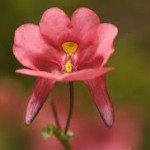 The common name of twinspur refers to the two downwardly pointing spurs found on the back of the flower. The spurs contain an oil which is collected in the South Africa wild by Rediviva bees. The female bees have unusually long, hairy forelegs that are used to collect the oil to feed her larvae. However, the Greek origin of the Diascia name doesn’t refer to the spurs, but rather the two sacs found in the upper part of the corolla. The flower petals help the bees to
The common name of twinspur refers to the two downwardly pointing spurs found on the back of the flower. The spurs contain an oil which is collected in the South Africa wild by Rediviva bees. The female bees have unusually long, hairy forelegs that are used to collect the oil to feed her larvae. However, the Greek origin of the Diascia name doesn’t refer to the spurs, but rather the two sacs found in the upper part of the corolla. The flower petals help the bees to  orient themselves to the oil glands of the spurs. While North Florida isn’t home to the Rediviva bee, we can grow Diascia and it is a wonderful opportunity to show the unique connection insects and plants can have. Look for other specialized flower structures and you will find other animals that fit them perfectly, even within the species found in the Panhandle.
orient themselves to the oil glands of the spurs. While North Florida isn’t home to the Rediviva bee, we can grow Diascia and it is a wonderful opportunity to show the unique connection insects and plants can have. Look for other specialized flower structures and you will find other animals that fit them perfectly, even within the species found in the Panhandle.

by Beth Bolles | Nov 4, 2014
Take a walk through the garden or woods this fall and you are sure to pass by a Green lynx spider. Unless you are very observant though, you will probably not realize that this common spider is perched upon flowers and low shrubs, ready to catch an insect meal.

An adult spider blends in well with plants. Photo by Beth Bolles, Escambia County Extension
Even though Green lynx spiders are very large, they are often well camouflaged in plant material. Spiders are bright green with a lighter color on the abdomen including some small red markings. The legs have distinctive black spines.
This spider does not spin a web but actively hunts insects using a dragline as it quickly moves or jumps over plants. It is an opportunistic feeder catching many types of insects that are visiting flowers. It has been noted as an important predator of some crop damaging insects.
Females will normally lay one egg sac in the fall and guard it from predators. It is constructed in the upper portions of branches and has webbing connecting it to nearby plant leaves. This webbing becomes a protective area for the emerged spiderlings until they are able to take care of themselves.
Lynx spiders pose no harm to people and should be considered one of many beneficial arthropods that we see in Florida.
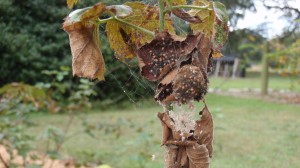
Young spiderlings on a blackberry guarded by the adult. Photo by Beth Bolles, Escambia Extension
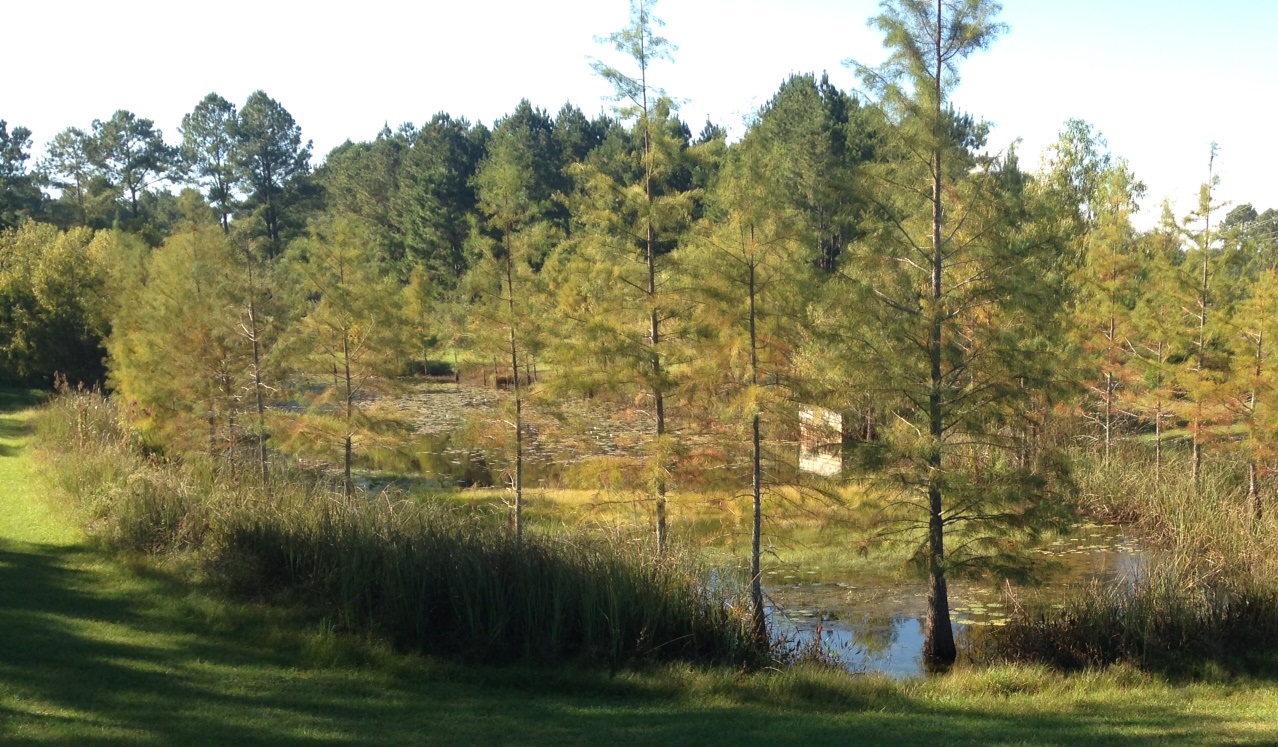
by Carrie Stevenson | Nov 4, 2014
I recently met with a group of community volunteers who are interested in providing more butterfly habitat in our public areas. Monarchs migrating to Mexico this time of year use northwest Florida as a stopover and feeding site, but if host plants are unavailable they cannot sustain a healthy population. In addition, Gulf fritillaries, buckeyes, and swallowtails are spending time in local butterfly gardens, feeding on passion vine, butterfly bush, milkweed, and more.
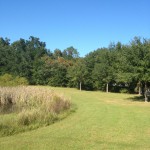
The grassy area between this stormwater pond and woods is an ideal location for a butterfly garden. Willows growing along the edge attract butterflies already. Photo credit: Carrie Stevenson
The volunteers and several county staff visited three publicly-managed stormwater ponds, which are an ideal setting for what some proponents term “Butterflyscaping.” The open space, water source, and diversity of plants along the edge of the ponds lend themselves well to wildlife habitat.

The permanently wet detention pond lined with cypress trees and sawgrass also provides habitat for fish, birds, and reptiles. Photo credit: Carrie Stevenson
When considering adding vegetation to a neighborhood common area, there are several things to consider. First is maintenance. If there’s an annual contract with a landscaping company to mow or maintain an area, you’ll want to have a discussion about excluding the new planting area from mowing to establish new vegetation. You’ll also want to look at the soil and amount of sunlight to determine the best plant choices for the area.
A variety of groundcovers, flowering plants, shrubs and small trees will typically provide food for both caterpillars and adult butterflies. Once established, these new landscape additions will not only provide habitat and color, but may end up reducing maintenance costs as well.
For more information, the UF publication “Community Butterflyscaping” is an excellent resource for landscape design, plant choices, and practical steps toward getting started with a neighborhood or schoolyard project.
by Beth Bolles | Oct 28, 2014
A common question about insects when cold temperatures arrive is whether or not the cold will kill many pests. Although temperatures will occasionally drop below freezing in north Florida, it is normally not cold enough to significantly impact insect populations for the upcoming year.

Typical white grub of the genus Phyllophaga. Photograph by John L. Capinera, UF / IFAS
Even when we do receive a significant amount of cold weather, insects have many methods to survive weather changes. Some insects survive by moving to micro-habitats that are more resistant to temperature fluctuations. Beetle larvae may move deep in the soil or into logs and trees for protection. The grubs can continue feeding on decomposing material throughout winter months. Beneficial insects such as dragonflies and damselflies stay protected in their nymph forms in the mud of ponds and lakes.
One of the most famous insect survival strategies is migration. We are all familiar with the late summer and fall flights of the monarch butterfly to warmer regions of Mexico and southern California. Those butterflies and moths that do not migrate have their own survival techniques. They will overwinter in protective pupal cases to emerge as adults in the spring. Moth cocoons are spun of silk and may be composed of multiple layers, making them a good protection for the transforming insect.
Insects are adapted for survival and can live through far colder winters than we experience. Even though our cold weather will not drastically change insect populations, periods of cold will at least slow down their activity enough for us to enjoy a break from many pest worries.

by Blake Thaxton | Oct 21, 2014
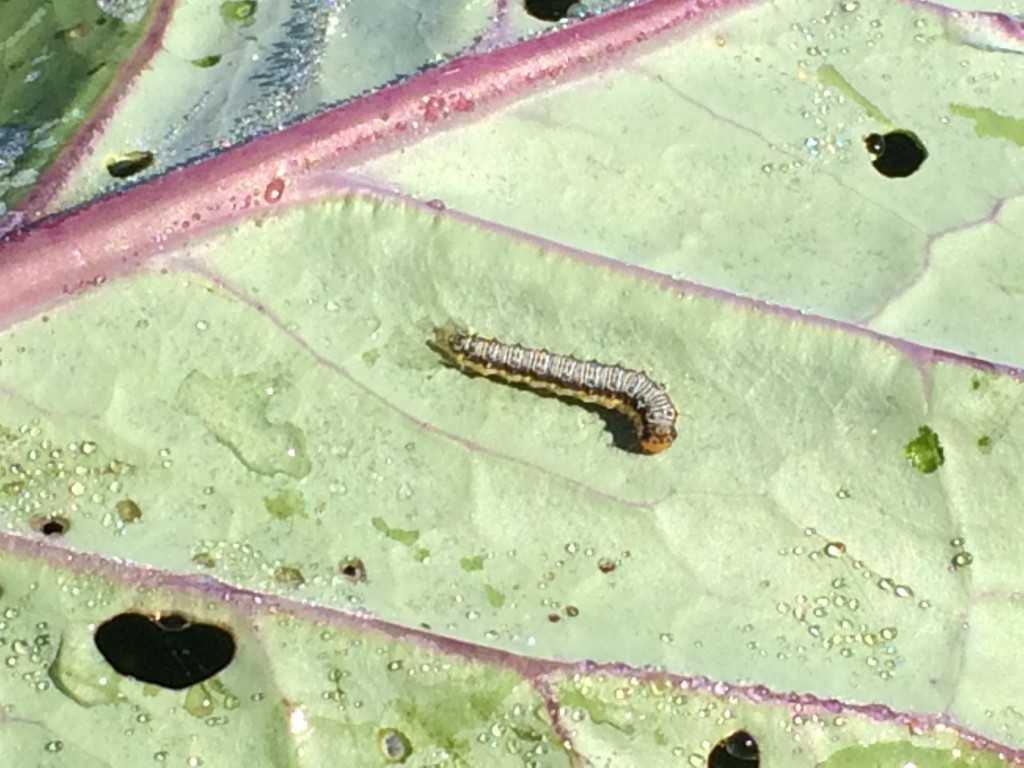
Cross-Striped Cabbageworm – Photo credits: Blake Thaxton
Panhandle gardeners have their fall gardens planted and our growing rapidly. What the gardeners may start noticing is shotgun damage to cabbage leaves in their garden. The suspect for this damage is the Cross-Striped Cabbageworm.
The Cross-Striped Cabbageworm have black and white markings on the back of the caterpillar and a bright yellow stripe on each side. This particular caterpillar feeds in cluster and maybe limited to a hot spot of a few plants in the garden or production area. They feed on tender parts of the cabbage including the terminal bud and can feed into the head once heading is initiated.
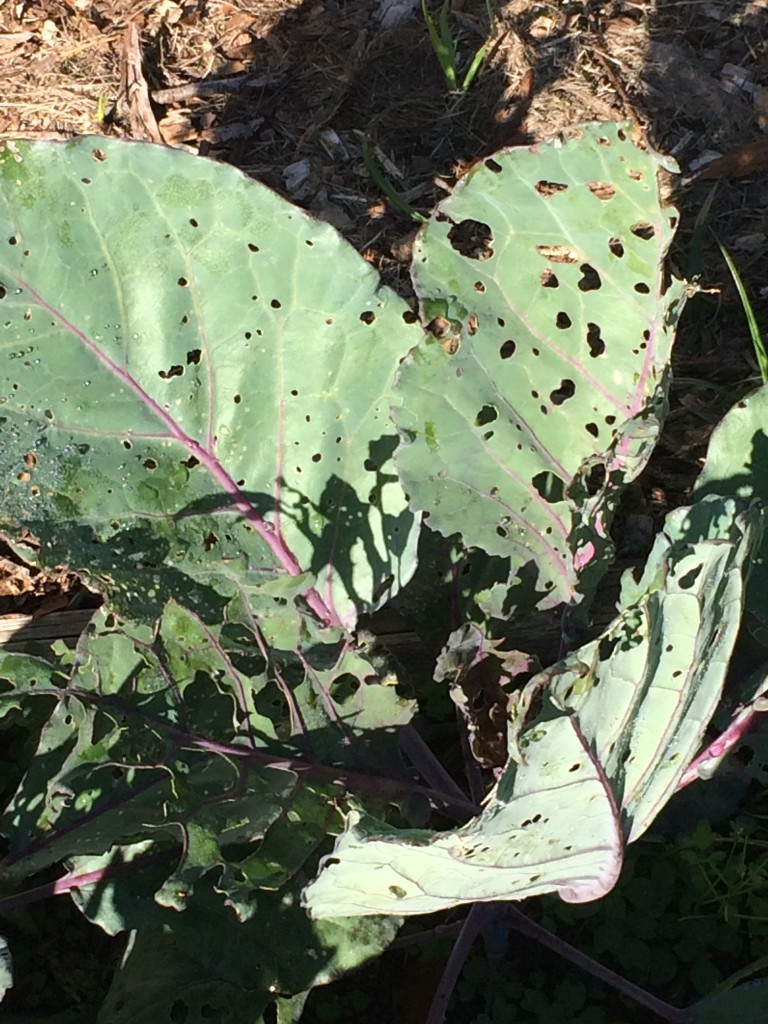
Damage caused by Cross-Striped Cabbageworm – Photo Credit: Blake Thaxton
With all pest control the three levels of control should be used:
- Level 1: Systems-based practices – weed control of pest host weeds
- Level 2: Mechanical and physical practices – A barrier, such as a light cloth that still allows enough light, can be used when the plants our young to prevent the moths from laying eggs on the cabbage.
- Level 3: Soft chemical & other materials – Bt (Bacillus thuringiensis) products can be used on the small-sized caterpillars. Harsher chemicals can kill the adults but in a garden situation picking them off and disposing them in a bucket of soapy water will do the trick as well.
by Beth Bolles | Oct 14, 2014
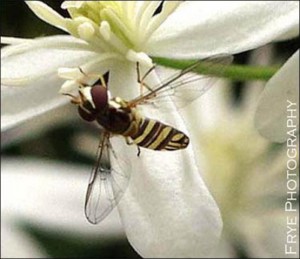
Hover Fly. Image Credit EDIS, Roy Frye
When someone mentions flies, we think of buzzing around our heads, maggots in decomposing materials, and unclean conditions. It is time to change those thoughts, at least in the garden. There are several flies commonly found in landscapes that provide a valuable service in pest management. The long-legged fly is a beautiful fly that is normally metallic copper, blue or green. It is very slender with long, thin legs and is common in most gardens. The larvae or maggots can be found in moist soil or rotted vegetation and like the adults are predaceous on aphids, thrips, mites, and other small-bodied arthropods. The hover fly is also found around flowers and has the rare ability to hover and fly backwards. Because of their yellow-striped abdomen and similar coloring, these flies are often mistaken for bees. Adults visit flowers for nectar and help with pollination while the larvae primarily feed on aphids.
The tachinid fly, is similar to the house fly in appearance, but is an excellent parasite of pest caterpillars, beetles and bugs. The adults are gray or black in color with stiff hairs on their bodies. The larvae spend their lives feeding inside the bodies of unwanted insects and are so valuable that exotic tachinids have been introduced into North America as part of biological control programs.
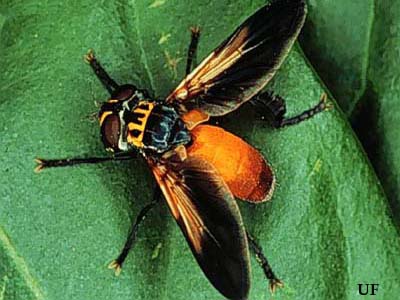
Tachinid Fly. Image Credit UF / IFAS Entomology Department

 Since 2005, multiple varieties of Diascia have added to the U.S. fall market of winter flowering plants. Its delicate flowers are far from ordinary though. In the early part of the last century most British gardening encyclopedias listed just one diascia – Diascia barberae – derived from seed collected by Col. J. H. Bowker and sent by Mrs. Barber to Kew Gardens, England, in 1870. Annual and perennial diascias had, of course, already been discovered and classified by several botanists visiting South Africa much earlier. The dainty, little annual, Diascia barberae, is not a very showy flower, but one which will appeal to the true flower lover. The flowers are rosy pink with yellow-green spots in the throat. The flowers are lipped, being related to the Snapdragons, but have two spurs on the lower lips, and are sometimes called twinspur. It was not until John Kelly was given a plant called Diascia cordata by Edrom Nurseries in 1971 that anything notable happened to diascias again. He took pollen from his Diascia cordata and applied it to one flower of Diascia barberae. Of the nine seeds he obtained, just one was worthy of attention. He named it Diascia ‘Ruby Field’ (not for the color of the flowers, but for a lady who devoted her live to the long-term care of deprived children). Despite the popularity of this new, hardy hybrid, little more happened with diascias for yet another decade. The boom in the diascia trade began only recently. Today’s diascia offers larger flowers, larger plants with a more open growth habit and colors ranging from scarlet through salmon and coral into pink. They bloom throughout the cooler weather and may behave as a perennial in warmer sites. But, the uniqueness of their flower structure and ecological role are as fascinating as the flower is beautiful.
Since 2005, multiple varieties of Diascia have added to the U.S. fall market of winter flowering plants. Its delicate flowers are far from ordinary though. In the early part of the last century most British gardening encyclopedias listed just one diascia – Diascia barberae – derived from seed collected by Col. J. H. Bowker and sent by Mrs. Barber to Kew Gardens, England, in 1870. Annual and perennial diascias had, of course, already been discovered and classified by several botanists visiting South Africa much earlier. The dainty, little annual, Diascia barberae, is not a very showy flower, but one which will appeal to the true flower lover. The flowers are rosy pink with yellow-green spots in the throat. The flowers are lipped, being related to the Snapdragons, but have two spurs on the lower lips, and are sometimes called twinspur. It was not until John Kelly was given a plant called Diascia cordata by Edrom Nurseries in 1971 that anything notable happened to diascias again. He took pollen from his Diascia cordata and applied it to one flower of Diascia barberae. Of the nine seeds he obtained, just one was worthy of attention. He named it Diascia ‘Ruby Field’ (not for the color of the flowers, but for a lady who devoted her live to the long-term care of deprived children). Despite the popularity of this new, hardy hybrid, little more happened with diascias for yet another decade. The boom in the diascia trade began only recently. Today’s diascia offers larger flowers, larger plants with a more open growth habit and colors ranging from scarlet through salmon and coral into pink. They bloom throughout the cooler weather and may behave as a perennial in warmer sites. But, the uniqueness of their flower structure and ecological role are as fascinating as the flower is beautiful.  The common name of twinspur refers to the two downwardly pointing spurs found on the back of the flower. The spurs contain an oil which is collected in the South Africa wild by Rediviva bees. The female bees have unusually long, hairy forelegs that are used to collect the oil to feed her larvae. However, the Greek origin of the Diascia name doesn’t refer to the spurs, but rather the two sacs found in the upper part of the corolla. The flower petals help the bees to
The common name of twinspur refers to the two downwardly pointing spurs found on the back of the flower. The spurs contain an oil which is collected in the South Africa wild by Rediviva bees. The female bees have unusually long, hairy forelegs that are used to collect the oil to feed her larvae. However, the Greek origin of the Diascia name doesn’t refer to the spurs, but rather the two sacs found in the upper part of the corolla. The flower petals help the bees to  orient themselves to the oil glands of the spurs. While North Florida isn’t home to the Rediviva bee, we can grow Diascia and it is a wonderful opportunity to show the unique connection insects and plants can have. Look for other specialized flower structures and you will find other animals that fit them perfectly, even within the species found in the Panhandle.
orient themselves to the oil glands of the spurs. While North Florida isn’t home to the Rediviva bee, we can grow Diascia and it is a wonderful opportunity to show the unique connection insects and plants can have. Look for other specialized flower structures and you will find other animals that fit them perfectly, even within the species found in the Panhandle.











